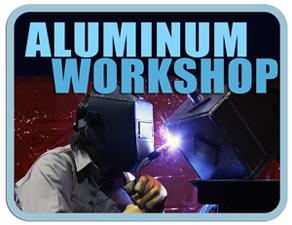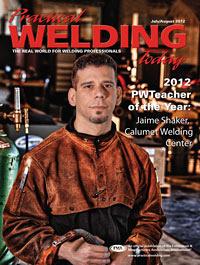President
- FMA
- The Fabricator
- FABTECH
- Canadian Metalworking
Categories
- Additive Manufacturing
- Aluminum Welding
- Arc Welding
- Assembly and Joining
- Automation and Robotics
- Bending and Forming
- Consumables
- Cutting and Weld Prep
- Electric Vehicles
- En Español
- Finishing
- Hydroforming
- Laser Cutting
- Laser Welding
- Machining
- Manufacturing Software
- Materials Handling
- Metals/Materials
- Oxyfuel Cutting
- Plasma Cutting
- Power Tools
- Punching and Other Holemaking
- Roll Forming
- Safety
- Sawing
- Shearing
- Shop Management
- Testing and Measuring
- Tube and Pipe Fabrication
- Tube and Pipe Production
- Waterjet Cutting
Industry Directory
Webcasts
Podcasts
FAB 40
Advertise
Subscribe
Account Login
Search
Aluminum Workshop: Adding weld strength with aging
- By Frank Armao
- November 20, 2014
- Article
- Aluminum Welding
Q: I plan to fabricate components using 6061-T4 and then age them after welding. I have heard than I can increase the welded strength this way. Is this true? What is the aging treatment? If I buy 6061-T4, which is aged at room temperature, will it keep aging in my shop? Will I eventually need to heat-treat it again if I store it in my shop for a long time in order to re-establish the T4 temper?
A: This is actually a very good practice. Aging does increase the welded properties significantly. If you weld 6061-T6, you will get welded strengths of about 25 KSI. If you use 6061-T4, weld it, and age it, you will get welded strength of about 34 KSI. You can use this processing sequence for any of the heat-treatable alloys, although the welded strengths will vary with the alloy.
To produce a T4 alloy in any of the heat-treatable alloys, the metal is heated to about 1,050 degrees F and then quenched, usually in water. All alloys will naturally age—gain strength—for some time after quenching. 6061 will gain strength for about two weeks after quenching and then stop. Other 7XXX alloys, such as 7005, will naturally age for several months after quenching, and gain quite a lot of strength. The good news is that all of the aluminum producers recognize this. When they sell T4 products, they have been held in the producer’s warehouse long enough so that the natural aging is finished and the aluminum is stable.
So if you keep T4 material in your shop for five years or so, has it changed? Are the properties no longer T4? The answer is no. Once the natural aging period is finished, the properties are stable and do not change, unless you perform an aging heat treatment.
So how do you do that? Well, actually, a number of time-temperature combinations can be used, depending on the alloy. For 6061-T4, a very common aging treatment is 400 degrees F for 2 hours, although others will work too. The good news is that this temperature is low enough that your component will not distort during the aging treatment.
I will close with two cautions. First, if you want to age after welding, you should use 4043, not 5356, as the filler metal. Second, while the technique I have described works very well, most codes, including AWS D1.2, will not allow you to take credit for the increased weld strength in your design calculations.
About the Author

Frank Armao
Aluminum Consulting Inc.
440-479-0239
About the Publication
Related Companies
subscribe now

The Welder, formerly known as Practical Welding Today, is a showcase of the real people who make the products we use and work with every day. This magazine has served the welding community in North America well for more than 20 years.
start your free subscription- Stay connected from anywhere

Easily access valuable industry resources now with full access to the digital edition of The Fabricator.

Easily access valuable industry resources now with full access to the digital edition of The Welder.

Easily access valuable industry resources now with full access to the digital edition of The Tube and Pipe Journal.
- Podcasting
- Podcast:
- The Fabricator Podcast
- Published:
- 04/16/2024
- Running Time:
- 63:29
In this episode of The Fabricator Podcast, Caleb Chamberlain, co-founder and CEO of OSH Cut, discusses his company’s...
- Trending Articles
Sheffield Forgemasters makes global leap in welding technology

Welding student from Utah to represent the U.S. at WorldSkills 2024

Lincoln Electric announces executive appointments

Engine-driven welding machines include integrated air compressors

ESAB unveils Texas facility renovation

- Industry Events
16th Annual Safety Conference
- April 30 - May 1, 2024
- Elgin,
Pipe and Tube Conference
- May 21 - 22, 2024
- Omaha, NE
World-Class Roll Forming Workshop
- June 5 - 6, 2024
- Louisville, KY
Advanced Laser Application Workshop
- June 25 - 27, 2024
- Novi, MI



























